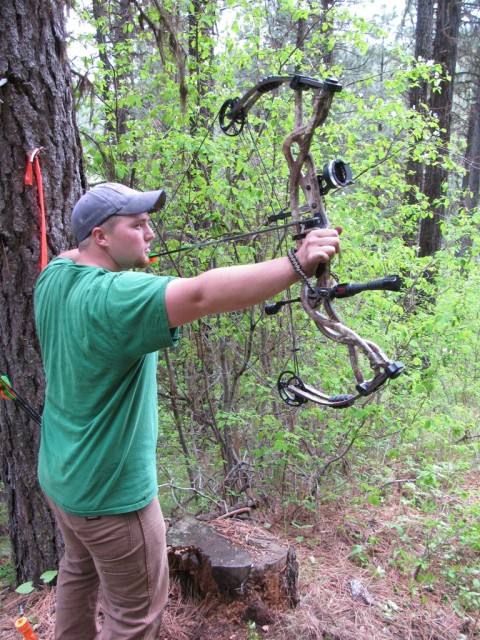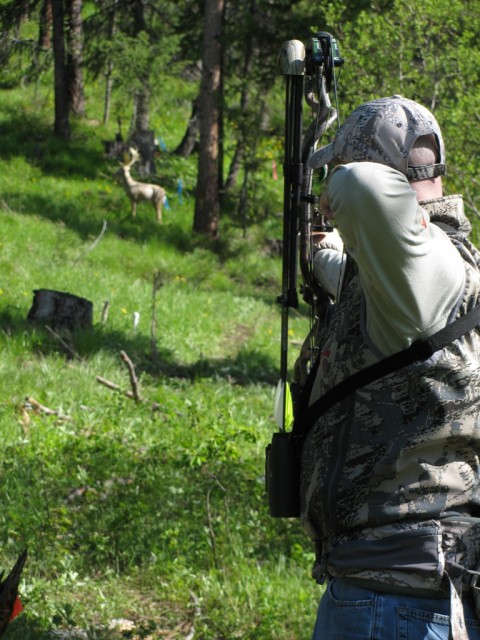Judging Distance
I remember my first encounter with archery. I stopped at ACE hardware while heading home after one of my college football games. We had played WV State that day and since the field was only 25 minutes from home, I headed home to get some squirrel hunting in before dark. I was a little beat up but I realized that if I got on the hill before I got sore I could kill something. This always made the week a little better. After 4 or 5 hours of lectures each day and practice in the afternoons, killing something seemed to get me ready for the next week. If I could handle it, I was going to go coon hunting after I got off the hill. My dogs needed to run a bit so I usually turned them out to chase a ‘possum or something every weekend that I could get home.
Then it happened. While in the store, a guy I had gone to High School with asked me if I wanted to buy his bow. I asked him to explain what it meant to bow hunt. Timmy Bowen then told me that you get to hunt more because of the archery season starting prior to anything else. And here we go on the judging distance thing.
I bought the Whitetail Hunter bow from him. The package included all his spent arrows, an old plastic thumb release, quiver, and 8 or 10 different sized and length aluminum arrows with broad heads installed. When I was growing up in WV, I only saw three deer by the time I was 10. Everybody that could, went to the mountains to hunt. Luckily, the girl I had been dating for a few years had a Dad who had a hunting camp in the Eastern Panhandle. There were a lot of little deer, but the key is there were a lot of them! So I shot a few times and headed to Hardy County. I put up a treestand and began shooting. I shot at everything that came near, but in the end I did not draw a hair. I went home and tried to find someone to help me. It seemed to have something to do with how far you were away from something and being in a tree. Well now I had it all. I gathered all my arrows and shot some more, different lengths, sizes and all. I was determined to figure this new way of killing something out.
A season of this prompted me to go to Addington’s Bowhunter shop. The owner, Frank, informed me that I at least need the same length and size arrows. Now I was set. Wrong. Another season of no hair or blood again made me look for answers. Some of the answers were in the gear. So I went to correct arrow sizes and lengths for the bow I was using. I then talked with a friend at the mouth of the hollow about this dilemma. He was an amateur, experiencing the same trouble – lots of shots and no connections.
 We took a serious look at how to practice our distance judging. This was back when the rangefinders were prisms that aligned, somewhat, when you twisted the knob and the tree looked straight. I promise there was no ARC or any other patented technology that compensated for angles. The modern rangefinder is for the demise of distance judging as the calculator is to the demise of talking business and figuring profit margins on the fly. I feel none of us bow hunters take enough effort to keep a keen sense of distance in our hunting portfolio. In those early days of my bow hunting, 28 years ago, Kenny and I set up anything that would stop an arrow at every possible angle and distance on his 20 acre hillside farm. I can sum up judging distance in this one sentence, then I will describe a few of the scenes that caused me to misjudge “yardage” or distance. The answer to judging yardage without a range finder is practice. Is not this the answer for most of the applications that we want to master in life?
We took a serious look at how to practice our distance judging. This was back when the rangefinders were prisms that aligned, somewhat, when you twisted the knob and the tree looked straight. I promise there was no ARC or any other patented technology that compensated for angles. The modern rangefinder is for the demise of distance judging as the calculator is to the demise of talking business and figuring profit margins on the fly. I feel none of us bow hunters take enough effort to keep a keen sense of distance in our hunting portfolio. In those early days of my bow hunting, 28 years ago, Kenny and I set up anything that would stop an arrow at every possible angle and distance on his 20 acre hillside farm. I can sum up judging distance in this one sentence, then I will describe a few of the scenes that caused me to misjudge “yardage” or distance. The answer to judging yardage without a range finder is practice. Is not this the answer for most of the applications that we want to master in life?
I will list some, if not most, of the situations I found to need more practice than others. Most of us practice in our back yards at a fixed target of fixed size with fixed ranges and fixed shot angles. Not always the best practice when it comes to elk hunting. Those who have “set up” the many times it takes to get a bull elk on the ground with archery equipment will testify that a lot of it happened so fast that they did not get to use the range finder. This is why practicing shots with your hunting equipment is so important. We all can probably do less than 30 yards with a flat or slightly sloping shot. Take this scenario away and it takes a lot of confidence away. And we all know that the success of what we do is reflected in the amount of confidence we take into the situation.
Some shots that elk archery hunters really need to be confident in are situations of steep slope shots and shots across areas that you cannot see the terrain. If the shot that is presented is similar to our back yard shooting we may get the job done. Change the game and if you are not prepared for it they will get away.
When you practice shooting for elk season you should try some of these shots to see if you perform adequately:
 Shoot very steep uphill and downhill.
Shoot very steep uphill and downhill.
Shoot across areas of hidden terrain (draws).
Shoot from light to dark areas and dark to light areas.
Shoot at different target sizes.
Shoot with different gear and clothing on.
Shoot with different levels of exertion.
Shoot at different temperatures.
Shoot at different adrenaline levels.
There are many more scenarios, but the more you prepare and practice the more successful you will be with your shot. I will tell you that a lot of it comes with misses. Experience and frustrations of missed opportunities was, and still is, my best teacher. I still get into situations and have to make a decision to make a shot in circumstances that I wish I had better prepared for. The number one advice is to practice in as many situations as you can imagine that you will have to react in.
I have a lot of “missing” stories, and I will disclose one of them to illustrate preparing for particular situations. I had trouble on more than a few occasions of shooting over elk at less than 15 yards. I could not figure the problem out. With my entire pin group fitting into the ribs of an elk how could I miss? Exactly. I was shooting over them because I was going back to a time in my life when I shot instinctive. I would shoot a centered pin group at close distance elk and that would send my arrow sailing high without results. I went home to Tennessee and bought myself a full size elk target. I quickly found out that I was hastening my shot and shooting instinctive. When I did this my twenty yard pin was near the backbone or above. I watched an arrow fly high on more than one elk hunting occasion because of this bad habit. Practicing with a life size elk in several different slope and distance applications has helped me with this tendency.
I hope this will encourage you to practice for the next two and ½ months in a different way than you ever have before. Practicing in different situations will give confidence for all types of hunting but it has definitely helped in the snap-shot style hunting and shooting that is often experienced when bugling elk.
